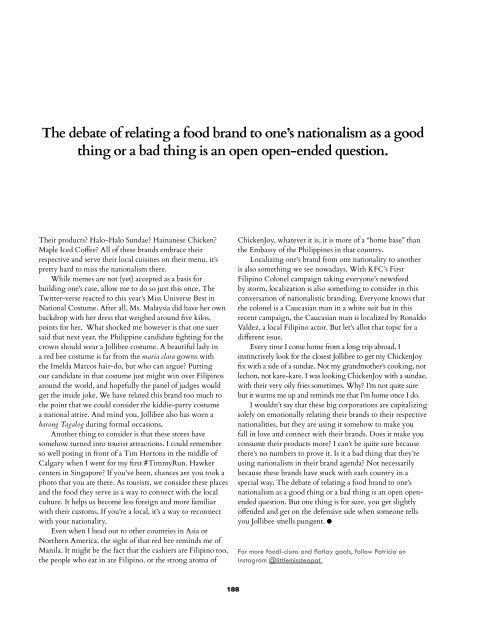Kanto Journal 3 Volume 2 2017
The Culture and Diaspora issue. A quarterly collaborative journal on architecture, photography, art and design, literature, food, and travel
The Culture and Diaspora issue. A quarterly collaborative journal on architecture, photography, art and design, literature, food, and travel
Create successful ePaper yourself
Turn your PDF publications into a flip-book with our unique Google optimized e-Paper software.
The debate of relating a food brand to one’s nationalism as a good<br />
thing or a bad thing is an open open-ended question.<br />
Their products? Halo-Halo Sundae? Hainanese Chicken?<br />
Maple Iced Coffee? All of these brands embrace their<br />
respective and serve their local cuisines on their menu, it’s<br />
pretty hard to miss the nationalism there.<br />
While memes are not (yet) accepted as a basis for<br />
building one’s case, allow me to do so just this once. The<br />
Twitter-verse reacted to this year’s Miss Universe Best in<br />
National Costume. After all, Ms. Malaysia did have her own<br />
backdrop with her dress that weighed around five kilos,<br />
points for her. What shocked me however is that one suer<br />
said that next year, the Philippine candidate fighting for the<br />
crown should wear a Jollibee costume. A beautiful lady in<br />
a red bee costume is far from the maria clara gowns with<br />
the Imelda Marcos hair-do, but who can argue? Putting<br />
our candidate in that costume just might win over Filipinos<br />
around the world, and hopefully the panel of judges would<br />
get the inside joke. We have related this brand too much to<br />
the point that we could consider the kiddie-party costume<br />
a national attire. And mind you, Jollibee also has worn a<br />
barong Tagalog during formal occasions.<br />
Another thing to consider is that these stores have<br />
somehow turned into tourist attractions. I could remember<br />
so well posing in front of a Tim Hortons in the middle of<br />
Calgary when I went for my first #TimmyRun. Hawker<br />
centers in Singapore? If you’ve been, chances are you took a<br />
photo that you ate there. As tourists, we consider these places<br />
and the food they serve as a way to connect with the local<br />
culture. It helps us become less foreign and more familiar<br />
with their customs. If you’re a local, it’s a way to reconnect<br />
with your nationality.<br />
Even when I head out to other countries in Asia or<br />
Northern America, the sight of that red bee reminds me of<br />
Manila. It might be the fact that the cashiers are Filipino too,<br />
the people who eat in are Filipino, or the strong aroma of<br />
ChickenJoy, whatever it is, it is more of a “home base” than<br />
the Embassy of the Philippines in that country.<br />
Localizing one’s brand from one nationality to another<br />
is also something we see nowadays. With KFC’s First<br />
Filipino Colonel campaign taking everyone’s newsfeed<br />
by storm, localization is also something to consider in this<br />
conversation of nationalistic branding. Everyone knows that<br />
the colonel is a Caucasian man in a white suit but in this<br />
recent campaign, the Caucasian man is localized by Ronaldo<br />
Valdez, a local Filipino actor. But let’s allot that topic for a<br />
different issue.<br />
Every time I come home from a long trip abroad, I<br />
instinctively look for the closest Jollibee to get my ChickenJoy<br />
fix with a side of a sundae. Not my grandmother’s cooking, not<br />
lechon, not kare-kare. I was looking ChickenJoy with a sundae,<br />
with their very oily fries sometimes. Why? I’m not quite sure<br />
but it warms me up and reminds me that I’m home once I do.<br />
I wouldn’t say that these big corporations are capitalizing<br />
solely on emotionally relating their brands to their respective<br />
nationalities, but they are using it somehow to make you<br />
fall in love and connect with their brands. Does it make you<br />
consume their products more? I can’t be quite sure because<br />
there’s no numbers to prove it. Is it a bad thing that they’re<br />
using nationalism in their brand agenda? Not necessarily<br />
because these brands have stuck with each country in a<br />
special way. The debate of relating a food brand to one’s<br />
nationalism as a good thing or a bad thing is an open openended<br />
question. But one thing is for sure, you get slightly<br />
offended and get on the defensive side when someone tells<br />
you Jollibee smells pungent.<br />
For more foodi-cisms and flatlay goals, follow Patricia on<br />
Instagram @littlemissteapat<br />
188



